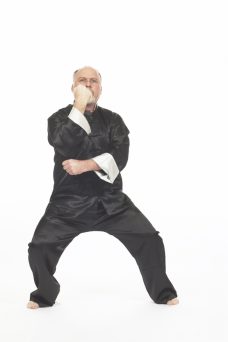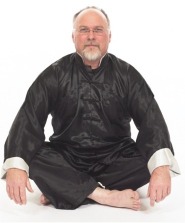This is an early piece written in a time of my transition from Karate to Tai Chi and before I started Chen Style – or met my current teacher Karel Koskuba or his teacher Grandmaster Chen Xiaowang – so probably about 15 years ago or possibly more.
———————————————————————-
To put my position clearly I should start by explaining that my own background is of about 15 years Shotokan practice and almost 10 years of Yang style Tai Chi, bringing them both together in the same body has become a continuing process. What follows then is as much an account of a personal journey as an intellectual/physical study.
At first glance most Karate student’s comment on Tai Chi is something along the lines of “what has it to do with fighting?” and yet there is (even now) a mystique attached to it in Karate literature and discussion. Sensei Nakayama I believe when asked “which is better Sensei, Karate or Tai Chi?” commented “Karate is for humans, Tai Chi is for supermen “. This mystique is added to today as we look, with limited understanding, at masters such as Kanazawa Shihan, who publicise their own practice and manage to maintain extraordinary ability into a stage of life when most people are considering problems doing day to day tasks. The health aspect and that of meditation/stress management for which Tai Chi has become known in the west has sanitised it, hiding the reality that it is a thoroughly practical martial art – it was first codified that way some 400 years ago, and is still regarded as that by teachers I have studied under in Beijing, Hong Kong and the UK. Some of whom do not see it as anything else and are bemused that anyone should consider it apart from its fighting applications.
Madam Yeung for example, daughter of the late Grandmaster Yang Shou-chung certainly considers her family style to be a martial art (and has the sense of humour to prove it!). So too with Madam Sun, daughter of Sun Lu-t’ang who originated Sun style Tai Chi from Xingi-chuan, Baghua and Wu/Hao style Tai Chi. At more than 80 years of age Madam Sun can still impress with her demonstrations, including a throat attack with the “tiger mouth” formed between thumb and forefinger that seems to bring a light to her eyes!
At a simplistic level we can see similarities in many postures, for example there are equivalents to the basic Uchi uke and Gedan barai, although in Tai Chi there are often a range of possible uses rather than the one or two generally taught to Karate students. Other examples of similarity come from various Kihon and Kata, all easier to demonstrate than describe. This is not really surprising, the bodies are the same and the aim of dealing with violence also the same, we should rather be surprised if such similarities did not exist.
Karate has its quota of fighting legends who would take on anybody, or went out onto the street looking for combat – so too has Tai Chi. Probably the best known of these was the founder of Yang style Yang Lu-ch’an who it seems was often challenged to prove his skill. Similarly Yang Ch’ien-hou, an imperial instructor, was once challenged to defend against attack with a spear. In more recent years Sun Lu-t’ang, originator of Sun style Tai Chi, managed to get quite a reputation as an outright fighter. The parallels continue, for example the saying “there is no first strike in Karate “, is matched by the words of Yang Lu-ch’an “when fighting with an opponent, do not move, but wait for the opponent to move, then move first.”
Read the full piece HERE






